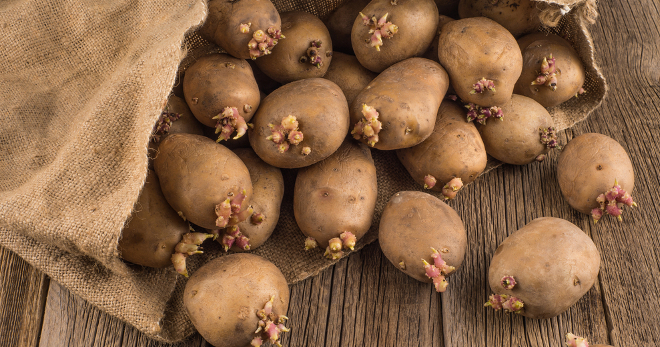 To get a good potato crop, it’s not enough just to plant it and harvest it when the tops are dry. In order for the results to please, it is necessary to take into account many nuances concerning, for example, the choice of variety, soil preparation, planting methods and elimination of pathogenic microflora.
To get a good potato crop, it’s not enough just to plant it and harvest it when the tops are dry. In order for the results to please, it is necessary to take into account many nuances concerning, for example, the choice of variety, soil preparation, planting methods and elimination of pathogenic microflora.
By listening to the advice of professionals and following their prompts, you will be able to significantly increase productivity and avoid spoiling the vegetable during storage.
Content
Potato Growing Methods
Thanks to the existence of many technologies, growing potatoes will not be difficult. However, some areas are characterized by a lack of fertile soil, which makes it impossible to plant such a crop to obtain a good crop.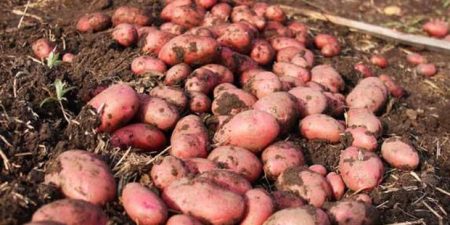
Bag growing
If the area is small, potatoes can be grown in bags. The main thing is that they are not too deep, otherwise the sprouts will not have the strength to develop normally and form tubers. Bags, if desired, are dug into the ground to a shallow depth.
On the balcony
Residents of cities can harvest in their balcony. To do this, store containers with holes for moisture. The containers must be cleaned with a disinfectant powder. The planting process itself resembles the cultivation of tubers in bags.
The cultivation of potatoes provides for good drainage, so large drainage holes must be made in the bottom and walls of the container.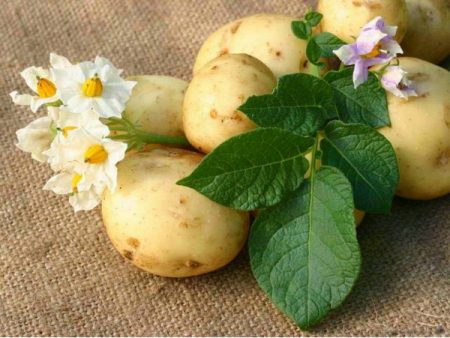
Landing Actions:
- First you should fill up loose soil filler with compost. The height of the layer is about 50 cm.
- On the ground, you need to put several tubers, which it is desirable to germinate in advance, add compost and water abundantly.
- When shoots appear, another layer of soil is added so that the stems are covered by about half. The process must be repeated until the stems reach the top of the container.
Useful advice: while the culture is at the ripening stage, it will need to be fed and watered three times when the soil dries.
To collect the tubers, simply turn the container over.
In the open ground
If there is enough space at the cottage, some successful ways to grow a potato crop will come in handy:
- Mitlider method, which involves the creation of narrow beds.
- The Gulich method, the essence of which is to allocate 1x1 m of land for each plant.
- The Dutch technology, according to which potatoes are planted in the ridges, which makes it possible to collect up to 2 kg from one bush.
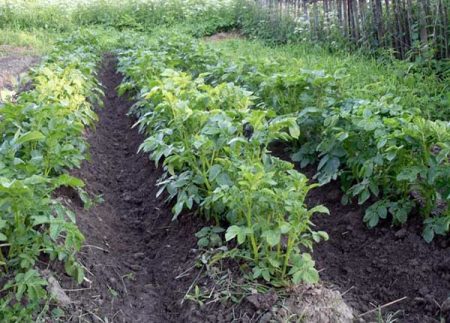
In Transbaikalia, the most effective way is a ridge planting with embedment of seed tubers to a depth of 10-12 cm.
The Chinese method is very popular, thanks to which a generous crop can be harvested even from a small site. The secret of the technology is simple: as the bush grows, the earth is sprinkled under the root, and it is necessary to take care of plentiful fertilizer. If you follow the tips, one bush can produce about 20 kg of tubers.
Before planting potatoes, the soil in the hole must be loosened, after which compost or manure (half a bucket) is poured.Ash (a handful) and superphosphate fertilizer will also come in handy.
Rules for growing potatoes in the open field
Regardless of the area of the garden, planting a potato crop should be in compliance with proven practice rules. Be sure to take into account the nature of the soil and climatic conditions.
Soil preparation
If possible, planting a crop every year is necessary in a new area. The best predecessors of potatoes: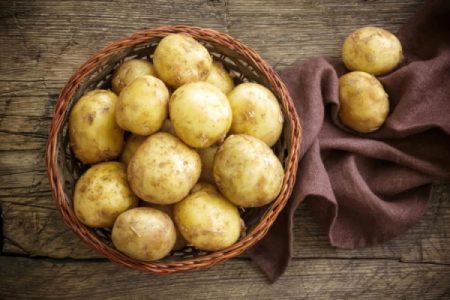
- pumpkin;
- cabbage;
- roots;
- legumes.
Before planting, open the bed should be dug up. This is done in the autumn and spring. If the digging is deep, the plant will be able to take root and develop properly.
It is desirable that the bed had a flat surface. But if the area under the potato is in the lowlands, where there is heavy soil and a high level of humidity, formation of ridges is recommended.
Features of the selection of varieties
As experts advise, every 4-6 years, the potato variety should be updated to prevent its degeneration. When choosing seed potatoes, you must reckon with:
- Zoning varieties. There are very few universal crops, so the variety is selected taking into account the region. For example, late varieties are not recommended for use in the suburbs and the Leningrad region. In extreme cases, they are planted in greenhouses.
- Ripening dates.
- Type of soil.
- The quality of the tubers.
- The number of eyes. Well, if there are a lot of them, while the potatoes should not be sprouted.
- Resistant to pests and bad weather.
- Tasting qualities.
- The ability to be stored during the winter period.
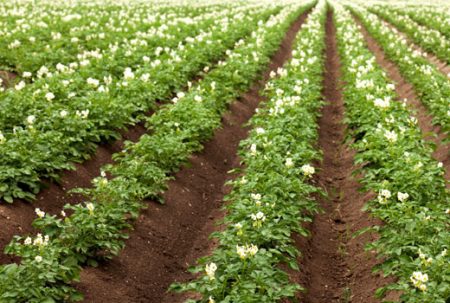
Well-established early varieties of domestic breeding - Moscow, Lorch, Korenevsky, Volzhanin. A large number of potato varieties used in Russia were created by breeders of Kazakhstan.
Preparing planting material
Planted tubers germinate one month in a warm place. During this time, you should sort out the material and remove those potatoes that have filamentous processes.
You will also need to sort out the potatoes before planting in the ground. In the presence of rotten sections of the tubers must be discarded.
Features of agricultural technology
Owners of gardens often encounter difficulties that are the result of non-compliance with agricultural techniques for growing crops. In order for the crop to be high, it is necessary to properly prepare the land. Due to the underdeveloped root system, potatoes need soil: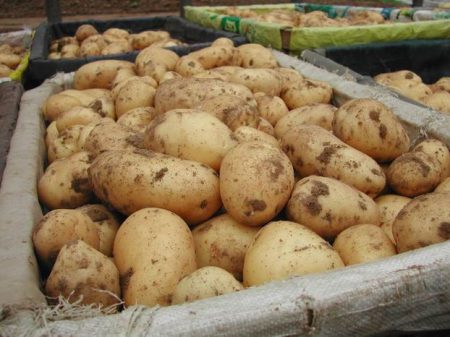
- fertile;
- permeable;
- warm enough.
The bed is necessarily leveled. Strong slopes should be avoided.
Tubers will actively germinate if the temperature of the earth at the depth where they are reaches 6-7 degrees.
When the potato begins to sprout, excess moisture will only damage it. Watering is necessary after the appearance of buds.
Timing and depth of landing
For almost any kind of potato, the optimum temperature for planting is a temperature of 7 degrees Celsius. In other words, you can start work from the second half of April or early May. In the Urals, the land warms up only in late May - early June. In Belarus, they also focus on soil temperature, while in the southern regions, planting is carried out in April (2 and 3 decades), and in the northern regions in May (1 and 2 decades).
Tubers are planted to a depth, the value of which depends on the type of soil and the variety of crop used. For example, residents of the northern and central regions can plant potatoes in this way: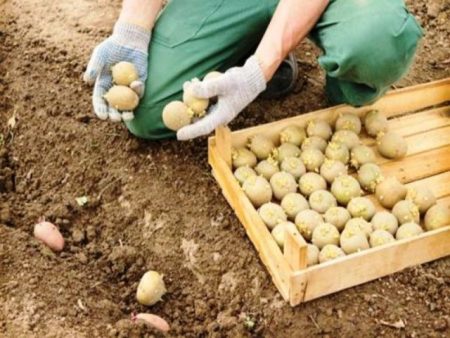
- on light soil, the permissible depth is 10-12 cm;
- if the soil is heavy - 8-10 cm;
- in the presence of peat soils - 6-7 cm.
In the southern regions, the indicator increases to 14-16 cm, since in these places the humidity is often low.
Planting and growing
Before planting tubers, they can be treated with a solution consisting of:
- copper sulfate - 0.7 g;
- boric acid - 0.5 g;
- manganese sulfate - 0.5 g;
- water - 1 l.
Thanks to such actions, the bushes will be less sick, and the content of starch and ascorbic acid in young tubers will increase.
If rows are made for early varieties, the distance between them should be half a meter. Later varieties should be planted at a slightly greater distance.
Do not get hung up on the traditional way of growing potatoes. There are many techniques whose implementation will help to achieve good results.
Potato Care Rules
After the tubers are in the ground, many prefer to wait for the harvest without any extra effort. However, potatoes will not be able to grow normally if there is no competent care.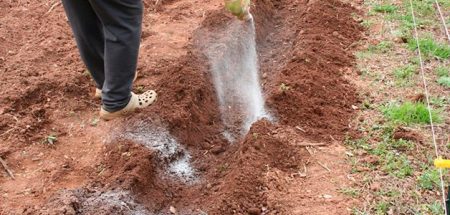
Fertilizer
The land plowed in spring needs fertilizer. Often the process is carried out using peat, compost, bird droppings, manure, potash and phosphorus fertilizers. It is also important to fertilize the soil in the fall so that early varieties get enough nutrition.
Crop Care
Loosening the soil before planting tubers will give it the necessary structure and relieve excess vegetation. In addition, it is necessary to observe temperature conditions. If you put the potatoes in the ground too early, the sprouts will die from frost. And, despite the fact that new ones will appear in their place, they will be too weak.
While there are no seedlings, the soil should be harrowed. For the first time this is done 5 days after planting the tubers, and subsequently the intervals between harrowing should be 7 days.
Watering
To support plant growth, it needs a certain amount of moisture. Watering is necessary if tubers form in a drought. However, excess water acts in a harmful way on the seed.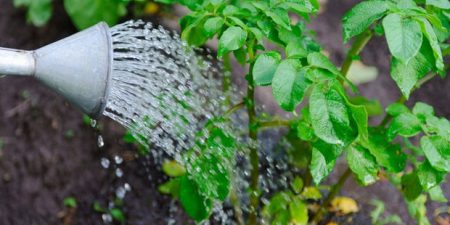
The second half of the growing season is the time when watering is most important for potatoes. But under appropriate weather conditions, watering may not be necessary.
Potatoes are watered in compliance with the rules:
- it is best to perform the procedure in the evening;
- one bush will need at least 3 liters;
- water is used previously defended and warmed up by sunshine.
Inter-row machining
Inter-row cultivation is carried out in the presence of bushes with a height of 12 to 15 cm. The soil must be loosened to improve moisture exchange and aeration, as well as to cut the root system of the weed grass. The number of loosening is not less than three, at the same time it should be buried by a maximum of 6-8 cm. Repeated processing is carried out after 14 days.
Hilling
During the summer period, planting spud 2-3 times. Stalks need to be sprinkled with earth from all sides. Such work should be done after watering the plant or rain.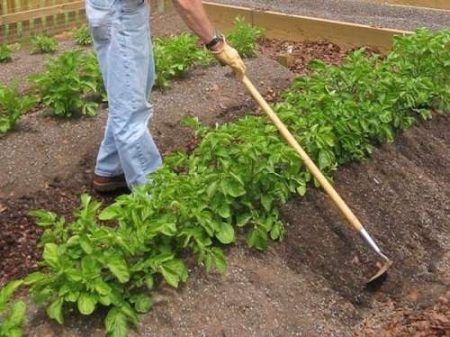
Top dressing
Often, potatoes are fed three times. The first feeding is necessary in the presence of weak tops, pale leaves and thin stems. Used composition with the use of urea (1 tbsp. L.) And water (10 l). You can add liquid mullein (0.5 l) or bird droppings. Half a liter of fertilizer is enough for the bush.
The next top dressing is carried out with the advent of buds. To speed up the process, potassium sulfate (1 tbsp.) And ash (3 tbsp.) Are diluted in water (10 l).
When the potatoes bloomed, the time comes for a third top dressing. So, you can activate the formation of tubers. A solution is prepared for the procedure: superphosphate (2 tbsp. L.) And chicken droppings (1 cup) are bred in a bucket of water.
If you properly look after potatoes, it will delight you with an excellent large crop.
Potato diseases and pests
Such a culture can be affected by late blight, silver scab, ring rot, rhizoctonia and other fungal diseases. If the product is not stored properly, bacterial rot can be detected. To prevent the development of diseases, attention should be paid to preventive measures.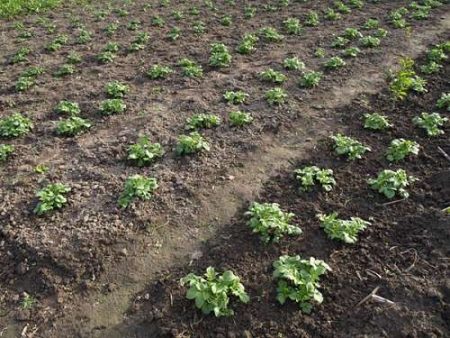
Pest Management and Disease Prevention
To keep the tubers healthy, helpful tips come in handy:
- For cultivation, you should choose only those varieties that are suitable for this region and have a high resistance to disease.
- If potatoes have been growing in one place for many years, each year the soil must be decontaminated.
- If sick bushes are found, they should be immediately eliminated. Tops affected by fungi should not be used for composting.
- It is undesirable to cut tubers before planting.
- Manure is not the best fertilizer for potatoes. It should be replaced with compost, mature humus, vermicompost.
Tubers and bushes before planting should be treated with special biological products. For example, during the growing season, you can use a solution of copper sulfate. And before hilling, the soil and bushes are sprinkled with wood ash.
Potatoes are most affected by the bear, wireworm, Colorado potato beetle, and nematodes. Against these pests, there are biological products that are harmless to the human body. On their list there is Nemabakt, Bikol, Bitoksibatsillin, Aktofit and other funds that are actively used, in particular, residents of the Moscow region.
How to plant potatoes in bags?
The essence of the method is as follows:
- Fertile soil is poured into the bags. The height of the layer depends on the depth of the tank and should be between 10 and 35 cm.
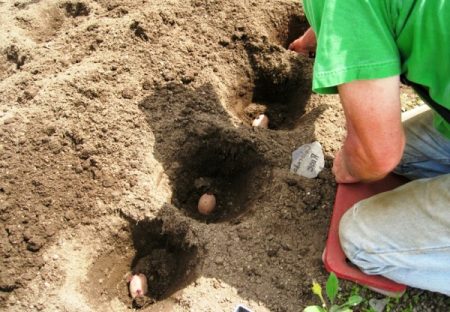
- Then the tuber is laid out (whole or cut into pieces) and covered with soil at 15 cm.
- The first shoots appear a week or two later. They need to be again covered with soil, so that the potatoes give new roots. Sprouts are poured repeatedly several times until 1/3 of the height remains to the edge of the bag.
Important: The best time to plant tubers is the emergence of sustained heat (late April - early May). It is not advisable to use bags that are too deep.
An improvised garden requires adequate lighting and timely watering. With the right approach with 4-5 tubers, gardeners get about 5 kg of potatoes.
The vertical method of growing crops saves space on the site and eliminates the need for regular weeding. In addition, the risk of pest damage is reduced.
Harvesting and storage of crops
During what period can I start harvesting potatoes? It should be guided by some signs:
- middle and late varieties are removed by yellowing and drying of the tops;
- picking early varieties can sometimes begin when the tops are still green.
Dry weather is suitable for work, however, in the presence of prolonged rains, the potatoes should be dug up and laid out in a prepared room for drying. If the harvest is not collected on time, approximately 80% of the tubers will die.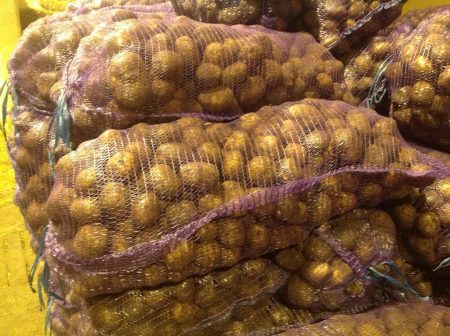
Dig the potatoes carefully so as not to damage the tubers. If this happens, potatoes should be put off. They are not suitable for long-term storage.
Digging up tubers, it is advisable to immediately select potatoes for sowing. They are taken from the most productive nests, in which there are no diseased tubers.
Harvested vegetables should be stored in a previously prepared room:
- disinfection is carried out for 15-20 days (bleach in an amount of 400 g is taken per 10 liters of water);
- to whitewash the walls, a solution of 1.5-2 kg of lime, 100 g of copper sulfate and 10 l of water is prepared;
- optimal temperature for storage - from 0 to 2 degrees of heat.
Reviews
It is not always possible to get a generous harvest by traditional methods, so many gardeners are looking for alternative options for planting potatoes, with which it will be possible to achieve the desired results.
On various forums you can find reviews on the effectiveness of certain techniques. Some people manage to grow potatoes in barrels, others - under the film, and others actively resort to the Chinese method. In other words, a universal method does not exist, since the normal development of culture depends on many factors.
For example, to harvest in the northern regions, potatoes are often grown in a greenhouse, because the tubers simply do not have time to ripen due to the short summer period.
The existence of a large number of methods of growing one of the most important agricultural crops is determined by the variety of climatic conditions and soil composition. The main thing is to choose the right method and adhere to the relevant rules.




 Description and description of varieties in Belarus with a photo
Description and description of varieties in Belarus with a photo Do I need to pick flowers from potatoes: why do they do it
Do I need to pick flowers from potatoes: why do they do it When to dig potatoes: timing and availability of new potatoes
When to dig potatoes: timing and availability of new potatoes How to grow a good potato crop: various methods and methods, planting and care
How to grow a good potato crop: various methods and methods, planting and care